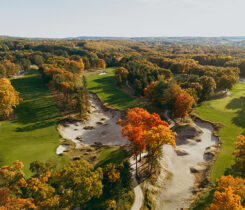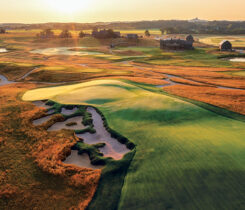Good greens in early spring
Aaron Patton, Ph.D., is an assistant professor of turfgrass science at Purdue University and devotes a portion of his research to improving golf course playing conditions. He can be reached at ajpatton@purdue.edu.
Q: What can superintendents do to provide greens that play well early in the spring?
I suggest doing five things. First, inspect all the greens and repair damaged areas. There is always some damage that occurs over winter from rodents, cross-country skiers, winter golfers or limbs falling on greens. Plug out damaged spots, hand topdress small areas with blemishes and blow off all the debris before rolling.
Second, roll to start the season. Greens in spring are usually uneven and a little soft. Rolling will smooth out uneven spots from frost heaving, help firm the surface up and to the delight of golfers, increase green speed.
Third, before you set the mowing height, stop to consider that spring is when creeping bentgrass and annual bluegrass will grow the root system they will need to last the entire summer. Are you sure you want to start stressing the grass right off the bat by using a low mowing height? Ease into mowing and low mowing heights, if at all possible. Alternate mowing and rolling.
Fourth, send out the mowers. Start mowing at a higher height and ease the height down over several weeks. Mow only as the grass grows. Rely on rolling to get the greens firm, smooth and fast. Or at least fast by spring
standards.
Lastly, don’t force leaf growth by over-fertilizing with nitrogen. Apply minimal nitrogen in early spring, no more than 0.25 lbs. nitrogen per 1,000 sq. ft. The turfgrass will green up and recover on its own using stored energy from last fall’s fertilization.
Q: What are your thoughts on annual bluegrass management or control in early spring?
For those who choose to suppress annual bluegrass seedheads, timing of application of Proxy (ethephon) or Embark (mefluidide) is everything.
An effective approach to determine ideal application timing is to monitor growing degree days (GDD), and once GDD accumulation has reached a defined range, apply your favorite seedhead suppressing PGR. This approach is used in Michigan, Illinois, Indiana and Ohio, where GDD accumulation is reported daily on a website starting March 1. The website can be found at http://www.gddtracker.net/. It’s helpful in determining the timing of Proxy and Embark applications.
If you choose to control annual bluegrass, don’t forget to keep your focus on creeping bentgrass health in early spring and don’t be overly aggressive with your annual bluegrass control program.
Q: What can be done in the fall to set up greens that perform well in early spring?
Fertilize with 1.0 lb. nitrogen per 1,000 sq. ft. in fall (one or more applications depending on your nitrogen source) so the plants can store energy for the spring. If you are so inclined, raise the mowing height slightly so there is more leaf area to photosynthesize and produce carbohydrates.
And consider topdressing late in fall once you have stopped mowing. The topdressing will help protect the crown, reduce desiccation injury and get the turfgrass off to a good start in spring.
Q: What are your thoughts on pigments and paints applied in early spring for color and to help warm up the soil?
So far, I haven’t seen much use of pigments or paints in Indiana in early spring. Superintendents are interested, but few have tried them yet. I understand the theory behind their use at certain timings but I have not seen any research that leads me to believe that there is a significant benefit to their use in spring on cool-season turf.










